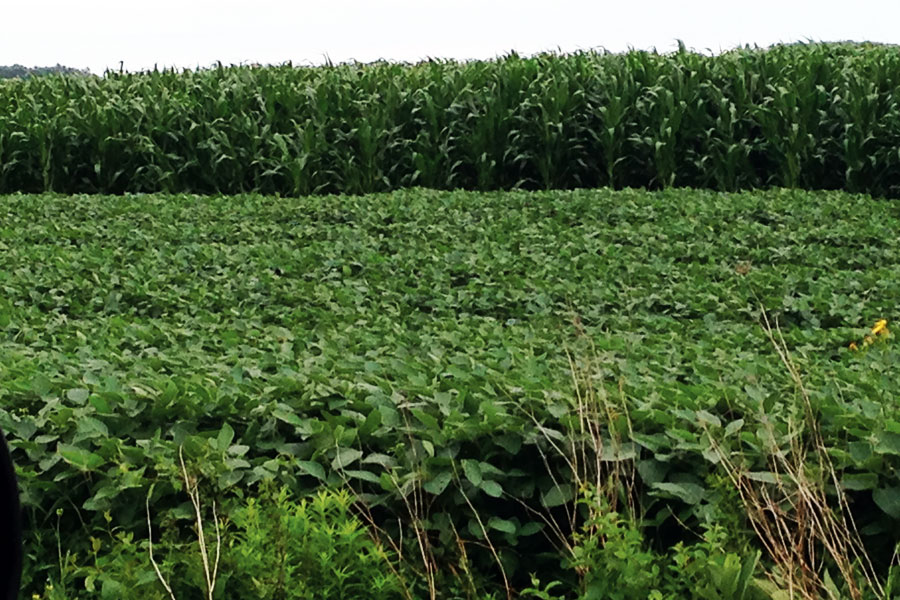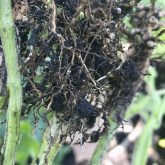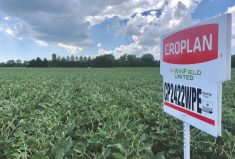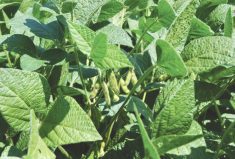Ask anyone involved in identity-preserved (IP) or non-GMO soybean trade, and there’s plenty to say in favour of Canada’s reputation abroad and its leadership in quality. Unfortunately, they’ll also tell you that it’s been a tough go in the past two or three years.
Since 2010, as total soybean production in Canada has increased, the IP sector’s share of that acreage has slipped, and slipped some more.
The reasons aren’t hard to understand. Round-up Ready varieties have become so convenient and abundant, many growers have abandoned the IP route, deciding to forgo sizable premiums in favour of an easier growing season.
Read Also

Producers aren’t panicking over tariffs and trade threats
The influence of tariff and trade uncertainity on farm business decisions.
Besides, a $1 or $2 premium for IP production looks more impressive on $8-per-bushel soybeans than it does with beans at $14.
That’s the hill that the IP sector has faced, and at the 2013 London Farm Show, one seed company representative tested premiums as high as $6.50 — at the time making a bushel of IP soybeans worth more than $20 per bushel — yet found no takers.
But that was March 2013. Today, in 2014, conditions in Ontario and abroad look markedly different, and interest in IP soybeans is showing signs of rebounding.
Even if these conditions last only for a year or two, the industry hopes it will be enough to build some long-term stability.
“Based on what we have contracted this year, and what we’re hearing from some of the competitors, I would say IP acres are up,” says Sue Robert, soybean and dry bean trader for Thompsons Ltd., in Blenheim, Ont. “The increase in acres has been tempered by the lack of seed in some varieties, but overall, grower premiums are slightly higher for 2014 than for 2013, which has certainly attracted growers.”
- More from Country Guide: The big change
Plus, adds Robert, the spectre of Roundup resistance is contributing to some second thoughts by many growers about the wisdom of going completely with GMO crush beans.
“Many growers are saying that if they have to tank mix in order to combat glyphosate-tolerant weeds, they might as well get paid for it,” Robert says. “They’ve shifted back to conventional soybeans, although we have to see if the shift lasts.”
The other part of the anti-GM sentiment is coming specifically from the European Union and, to a lesser degree from increasing consumer demand for labelling and traceability.
“Labelling and traceability will become mandatory in the future, and all consumers want to know where their food comes from, and that it was grown in a safe and sustainable manner,” says Robert, adding it doesn’t mean they want organic or labelling of everything. “But they want assurances that if growers are using chemicals — whether it’s to combat an insect pest or weeds — the pesticide or herbicide is used responsibly, and that any residues are below Health Canada’s established minimum residue levels (MRL).”
Robert says the sophistication of Ontario growers and the network of elevators geared to IP handling should put the province’s IP soybeans at the forefront for traceability.
Contracts booked, looking to 2015
Premiums need to be attractive enough to bring growers back, but there’s a delicate balance that has to be struck. Global IP demand will absorb higher premiums, but only to a point.
“There are parts of the world that definitely want non-GMO, and they won’t take anything else,” says Bob Hart, president of Sevita International. “And there are a lot of parts of the world that would prefer non-GMO but if it gets too expensive, they’ll use GM. So we need to be careful not to price ourselves out of the market.”
Japan and the European Union have been destinations of choice for Canadian IP soybeans. However, Hart notes that in Japan, food retailers now have greater influence on pricing. Tofu-based foods are increasingly being used as loss leaders to entice customers, he points out. So tofu processors, along with soy milk processors, are getting squeezed, which explains Hart’s concern about pricing ourselves out of the market.
In the European Union, meanwhile, the U.S. is emerging as an aggressive price competitor. “What we’re hearing is that the Americans are trying to come in cheaper than we are. And in certain areas, their quality is good. Our protein tends to be a little bit higher but Americans can produce good quality.”
Low numbers point to opportunity
Martin Vanderloo, president of Huron Commodities in Clinton, Ont., is the first to concede there have been challenges with establishing a stronger, more consistent presence for the Canadian IP sector. In 2010, Canadian soybean production was 4.3 million tonnes, with 1.5 million tonnes grown as non-GMOs, or 34.9 per cent of total production. In 2012, overall production jumped to 4.9 million tonnes, yet non-GMO soybeans accounted for 1.0 million tonnes, or only 20.4 per cent.
Then, based on last year’s estimates, Vanderloo says total production jumped to nearly 5.0 million tonnes, with just 875,000 tonnes of non-GMOs. That’s right around 18 per cent.
“We’ve had a shift upwards in soybean production, but a major decline in non-GMOs,” says Vanderloo. “But I think that here in Ontario, we’ll be back to 25 per cent of total soybean production going to non-GMO varieties, and it could be a little higher than that.”
The biggest change from Vanderloo’s perspective — aside from South American production or a delayed start to the U.S. planting season — is the economic hangover caused by higher commodity prices in the last few years.
“The last few years, farmers would say to us, ‘I’m not going to bother growing non-GMO or IP varieties — it’s just more work, it’s more of a hassle, it’s a bit of a risk, and I’m making so much money growing soybeans, I don’t want to mess with what I’m doing now,’” says Vanderloo. “Then last fall, one of our growers came storming in the door after he finished taking his corn off, and he asked if we have any programs in 2014 for IP soybeans. When we said, ‘Yes,’ he said, ‘Well, I’m growing all soybeans, I’m not growing any corn, I can’t afford to grow corn!’”
At the same time, Vanderloo maintains that many of the larger growers refuse to get caught up in the volatility of the commodity market. Year after year, they stick to corn-soybeans-wheat, and rationalize it through the spreading of workload that the three require, or that there’s a consistency in yield with the three that they can’t afford to put at risk.
Closer to home
Scott Sheppard is one of these growers who has measured Roundup Ready soybeans against IP varieties. Sheppard works with his father and brother Trevor on the family’s Sheppland Farms operation near Selkirk, southeast of Simcoe, Ont. The Sheppards work about 3,200 acres and have a three-year, two-crop rotation with 2,200 acres of IP soybeans for two years, and the other 1,000 planted to wheat. Depending on the economics and the year, they can also finish 7,000 and 7,500 pigs every 16 weeks.
Sheppard farms with a different eye on the IP sector. He’s certainly interested in the economics of growing IP soybeans, but not from the same perspective on global supply and demand or trying to establish greater consistency in Canadian IP production. Those matters fall more to Vanderloo, Hart or even the Grain Farmers of Ontario or the Canadian Soybean Export Association (CSEA).
For Sheppard and his father and brother, the concerns always land a little closer to home.
“It’s one of those things where you look back every year and it works. We seem to struggle with weed control some years, based on what we get for weather, but we’re always in that 2,000- to 2,500-acre area for IPs,” says Sheppard. Back in April, he was concerned with winterkill in his wheat, so there are challenges and decisions to be made from year to year. “But it comes back to the same thing, where we need so many acres for our nutrient management plan and there are other factors that come into play, and yet every year, there seem to be that same 2,000 to 2,500 acres of IPs.”
As for attracting and maintaining higher production numbers for IP soybeans, Sheppard points to the costs and convenience, as well as combining. When the price in Chicago is unusually high — on the plus side of $13 or $14 per bushel — and seed companies are offering discounts for early payments with lower-cost chemicals, the advantage often goes to the grower with Roundup Ready soybeans.
Sheppard works with a computer spreadsheet that can compare the costs and revenues of GM soybean varieties versus IP production. The deciding factor is often wrapped up in the harvest.
“With IPs you want to combine your beans, and the guys with Roundup Ready are combining at 8:30 or 9 a.m.; there’s a little bit of dew but they can go, because mud-tagging or staining isn’t an issue to them nor is the moisture,” says Sheppard. “But for us, it’s usually 11 a.m. before we can start combining, because we have to let everything dry up. So it’s not just growing them and your input costs, now you’re going to be shipping them and they have to make grade.”
The first question Sheppard acknowledges when considering growing IP soybeans is, “How much is the premium?” That’s always first, and it’s almost always followed by, “Is the premium worth the effort?”
For the Sheppards, the important answer is to the second question, and the answer is “yes.”
“You hope at the end of the year that there’s more to your bottom line, but it seems that in the ag business, you get good corn prices, good bean prices or good wheat prices, fertilizer goes up $100 per ton, and chemicals go up or seed costs go up,” says Sheppard. “And it seems at the end of the year you’re working with the same percentage or ratio that you had a year before.”
















